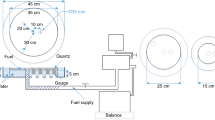Abstract
The emissivity of the double pool fires (DPF) is helpful in radiative heat transfer calculations, fundamental research, and numerical simulations. In this work, emissivity measurements are performed on 0.1 m gasoline circular DPF using infrared camera. Along with emissivity measurements, the mass burning rate (MBR), flame merging probability, and height are also measured. The results show that MBR, flame merging probability, height, and emissivity increase with a decrease in non-dimensional separation distance (S/D). The variation of emissivity along the flame height is also studied and realised that it decreases with the increase in flame height.














Similar content being viewed by others
References
Vasanth S, Tauseef SM, Abbasi T, Abbasi SA (2014) Multiple pool fires: occurrence, simulation, modeling and management. J Loss Prev Process Ind 29:103–121. https://doi.org/10.1016/j.jlp.2014.01.005
Huffman KG, Welker JR, Sliepcevich CM (1969) Interaction effects of multiple pool fires. Fire Technol 5:225–232. https://doi.org/10.1007/BF02591520
Kamikawa D, Weng WG, Kagiya K, Fukuda Y, Mase R, Hasemi Y (2005) Experimental study of merged flames from multifire sources in propane and wood crib burners. Combust Flame 142:17–23. https://doi.org/10.1016/j.combustflame.2005.02.004
Sudheer S, Prabhu SV (2012) Measurement of flame emissivity of hydrocarbon pool fires. Fire Technol. https://doi.org/10.1007/s10694-010-0206-5
Sudheer S, Kumar L, Manjunath BS, Pasi A, Meenakshi G, Prabhu SV (2013) Fire safety distances for open pool fires. Infrared Phys Technol. https://doi.org/10.1016/j.infrared.2013.09.006
Planas-Cuchi E, Chatris JM, López C, Arnaldos J (2003) Determination of flame emissivity in hydrocarbon pool fires using infrared thermography. Fire Technol 39:261–273. https://doi.org/10.1023/A:1024193515227
Àgueda A, Pastor E, Pérez Y, Planas E (2010) Experimental study of the emissivity of flames resulting from the combustion of forest fuels. Int J Therm Sci 49:543–554
Ji J, Ge F, Qiu T (2021) Experimental and theoretical research on flame emissivity and radiative heat flux from heptane pool fires. Proc Combust Inst 38:4877–4885. https://doi.org/10.1016/J.PROCI.2020.05.052
Raj VC, Prabhu SV (2018) Measurement of geometric and radiative properties of heptane pool fires. Fire Saf J 96:13–26. https://doi.org/10.1016/j.firesaf.2017.12.003
C. Qian, K. Saito, Measurements of pool-fire temperature using IR technique, in: Combust. Institute/Central West. States Combust. Institute/Mexican Natl. Sect. Am. Flame Res. Committee. Combust. Fundam. Appl. Jt. Tech. Meet. Proc., 1995: pp. 81–86.
Zhao J, Wang S, Zhang J, Zhou R, Yang R (2020) Experimental study on the burning characteristics of transformer oil pool fires. Energy Fuels 34:4967–4976. https://doi.org/10.1021/acs.energyfuels.0c00175
A. Arakawa, K. Saito, W.A. Gruver, Automated infrared imaging temperature measurement with application to upward flame spread studies. Part I, Combust. Flame. 92 (1993) 222--IN2.
Wan H, Gao Z, Ji J, Sun J, Zhang Y, Li K (2018) Predicting heat fluxes received by horizontal targets from two buoyant turbulent diffusion flames of propane burning in still air. Combust Flame 190:260–269
Wan H, Ji J, Li K, Huang X, Sun J, Zhang Y (2017) Effect of air entrainment on the height of buoyant turbulent diffusion flames for two fires in open space. Proc Combust Inst 36:3003–3010. https://doi.org/10.1016/J.Proci.2016.07.078
Wan H, Yu L, Ji J (2021) Experimental study on vertical temperature distribution of symmetry axis of two identical rectangular pool fires with long sides parallel. Fire Saf J 120:103044
Jiao Y, Gao W, Liu N, Lei J, Xie X, Zhang L, Tu R (2019) Interpretation on fire interaction mechanisms of multiple pool fires. Proc Combust Inst 37:3967–3974. https://doi.org/10.1016/j.proci.2018.06.049
Zhang S, Liu N, Lei J, Xie X, Jiao Y, Tu R (2018) Experimental study on flame characteristics of propane fire array. Int J Therm Sci 129:171–180. https://doi.org/10.1016/J.IJTHERMALSCI.2018.02.024
Ma P, Wang B, Kong D, Tao C, Chu H (2018) An experimental study of the merging probability of double buoyancy-controlled jet flame. Exp Heat Transf 31:121–130. https://doi.org/10.1080/08916152.2017.1397816
Babrauskas V (1983) Estimating large pool fire burning rates. Fire Technol. https://doi.org/10.1007/BF02380810
Dupuy JL, Vachet P, Maréchal J, Meléndez J, de Castro AJ (2007) Thermal infrared emission–transmission measurements in flames from a cylindrical forest fuel burner. Int J Wildl Fire 16:324–340
C. Balaji, Essentials of Radiation Heat Transfer, John Wiley & Sons, 2014. https://books.google.co.in/books?id=CNn1AwAAQBAJ&dq=essentials+of+heat+transfer&hl=en&sa=X&ved=0ahUKEwiNlseC9LLbAhXHfX0KHRcNBc0Q6AEIODAD.
B.J. McCaffrey, Purely buoyant diffusion flames: Some experimental results, National Bureau of Standards (U.S.A.), 1979. https://ci.nii.ac.jp/naid/10018669054/.
J.G. Quintiere, Fundamentals of fire phenomena, John Wiley & Sons., 2006.
Lu K, Hu L, Delichatsios M, Tang F, Qiu Z, He L (2015) Merging behavior of facade flames ejected from two windows of an under-ventilated compartment fire. Proc Combust Inst 35:2615–2622
Otsu N (1979) A threshold selection method from gray-level histograms. IEEE Trans Syst Man Cybern 9:62–66
Sudheer S, Prabhu SV (2010) Measurement of flame emissivity of gasoline pool fires. Nucl Eng Des. https://doi.org/10.1016/j.nucengdes.2010.04.043
A.J. Wheeler, A.R. Ganji, Introduction to Engineering Experimentation, Pearson Higher Education, 2010.
Author information
Authors and Affiliations
Corresponding author
Ethics declarations
Conflict of interest
The authors declare that they have no known conflict of interest.
Additional information
Publisher's Note
Springer Nature remains neutral with regard to jurisdictional claims in published maps and institutional affiliations.
Rights and permissions
Springer Nature or its licensor (e.g. a society or other partner) holds exclusive rights to this article under a publishing agreement with the author(s) or other rightsholder(s); author self-archiving of the accepted manuscript version of this article is solely governed by the terms of such publishing agreement and applicable law.
About this article
Cite this article
Bathina, S.K., Siddapureddy, S. Effect of Spacing Between the Double Pool Fires on the Flame Emissiviy and Temperature. Fire Technol 59, 2481–2497 (2023). https://doi.org/10.1007/s10694-023-01428-1
Received:
Accepted:
Published:
Issue Date:
DOI: https://doi.org/10.1007/s10694-023-01428-1




